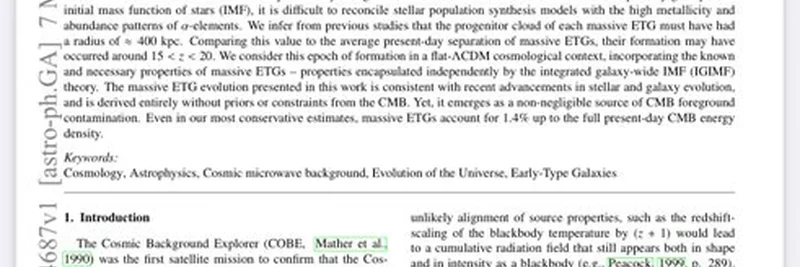The James Webb Space Telescope (JWST) is turning the world of astrophysics upside down with its latest findings, and it’s all thanks to some unexpectedly ancient galaxies. A recent post on X by cascadian realism fan dives into a groundbreaking paper suggesting that these early mature galaxies (EMGs) could explain the entire energy density of the Cosmic Microwave Background (CMB) radiation. This is a big deal because the CMB has long been seen as a snapshot of the universe just after the Big Bang. Let’s break it down and see what this means for our understanding of the cosmos!
What’s the Cosmic Microwave Background Anyway?
Imagine the CMB as the oldest "light echo" we can detect, dating back to when the universe was about 379,000 years old. It’s like a baby photo of the universe, showing tiny temperature differences that hint at how galaxies and stars formed. Scientists have relied on it to support the Big Bang theory, cosmic inflation, and even concepts like dark energy and dark matter. But now, JWST’s discoveries are throwing a curveball into this picture.
The Plot Twist: Early Mature Galaxies
The JWST has spotted massive galaxies that formed way earlier than anyone expected—some with complex elements like carbon and nitrogen, which shouldn’t exist so soon after the Big Bang. The paper, highlighted in the X post, suggests these galaxies’ energy output might account for the CMB’s energy density. That’s a huge shift! If true, it could mean the CMB isn’t just a relic of the Big Bang but is influenced by these ancient stellar powerhouses.
Why This Matters
The X post lists a laundry list of cosmological ideas that could be upended: the Big Bang theory, cosmic inflation, dark energy, and more. It’s not just about tweaking a model—it’s a potential overhaul. The idea is that if these galaxies’ energy mimics the CMB, then what we thought was a pristine signal from the universe’s birth might be contaminated by these stellar giants. This challenges the "cleaning" processes scientists use to study the CMB and questions the age and structure of the universe itself.
The Science Community’s Reaction
The thread shows a mix of excitement and skepticism. Some users, like Jordan Taylor, argue this could expose circular reasoning in current models—where the CMB’s data shaped our galaxy formation theories, which now loop back to explain the CMB. Others, like Axel, see it as science doing its job: testing theories against new evidence, as Richard Feynman famously said. But the original poster isn’t holding back, calling it a "massive L" for astrophysicists’ overconfidence.
What’s Next for Cosmology?
This discovery doesn’t mean the Big Bang is dead—it’s more like a wake-up call. The JWST is giving us a front-row seat to the universe’s early days, and it’s clear we need new models. The X post suggests everything from the Hubble constant to gravitational lensing might need a rethink. For blockchain practitioners and space enthusiasts alike, this is a reminder that science evolves with new data, much like how meme tokens adapt to market trends.
If you’re into space mysteries or just love a good scientific shake-up, keep an eye on meme-insider.com for more updates. We’ll be tracking how this unfolds and what it means for the future of cosmology. What do you think—will this redefine our cosmic story?



